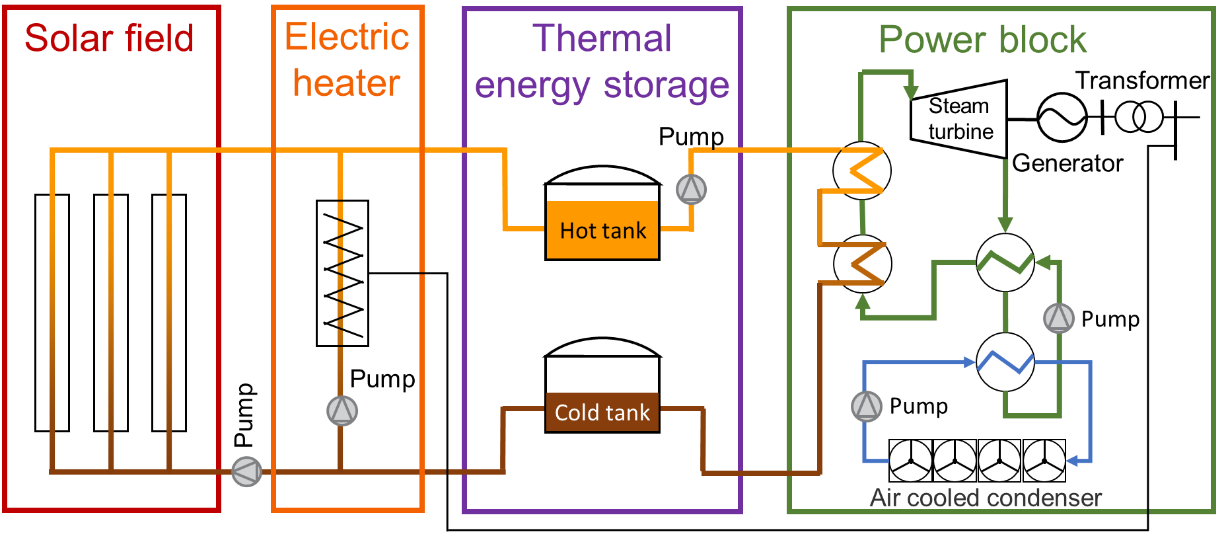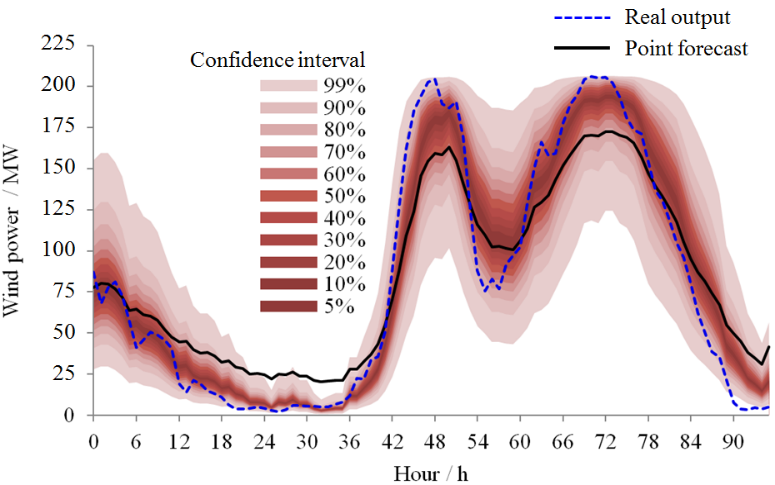Renewable Energy Analytics and Optimization
The fast development of renewable energy continuously changes the behavior of the power system. Uncertainty and variability are the two most significant features of renewable energy. However, power systems have always been designed for controllable generators such as thermal and hydro-power generators instead of intermittent energy for more than a century. The uncertainty and variability of renewables will fundamentally change the way that the power system balances the generation and load. To face this ever-changing power system trend, we conduct research on two aspects: 1) New model and methodology to model and analyze the stochastic behavior of renewable energy. We propose modeling theory and output simulation model for the stochastic behavior of wind power and wind power and photovoltaic (PV), especially their spatiotemporal dependence. The capacity credit calculation and analytical model is also proposed. 2) New type of renewable energy generator: concentrated solar power. The modeling, operation and planning of concentrated solar power is studied in detail. Other renewable energy research can also be found at Power System Planning & Operation and Multiple Energy System Integration.
Modeling and simulation of the stochastic behavior of wind power, photovoltaic
 |
For output simulation of wind power, PV, we propose a methodology for simulating the operation of multiple wind farms and PV stations. For wind power output, we first generate the correlated wind speeds of different wind farms by using a stochastic differential equation that accounts for marginal distribution and time sequencing. The wind power output is further obtained using the wind power output characteristic function. For PV output, we generate the time series of unshaded solar irradiation and the clearness index and then calculate the PV outputs considering the solar panel power output characteristics as well as their tilt and direction of deployment. The proposed methods provide a useful tool for renewable energy operation and planning.
The capacity credit of renewable energy
This model provides a analytical method to calculate the capacity credit accurately even when the wind power penetration is large and the wind power and load profile are not statistically independent. The model also quantitively shows how the system and renewable energy characteristic affects the capacity credit. Furthermore, based on the capacity credit estimation model, we propose a wind power planning optimization model that considers both the energy and capacity benefit of wind farms. The proposed model can overcome the drawbacks that current model only considers energy benefit and may mislead the investment, resulting in a low wind power capacity credit.
Concentrated solar power operation and planning
 |
Concentrated solar power is an emerging renewable technology which is almost as controllable as thermal power generator. We propose systematic methods for power system operation, planning and simulation evaluation with the presence of CSP to facilitate high renewable energy penetrations. From the perspective of power system operation, we propose a scenario-based three-stage stochastic unit commitment model considering the uncertainty and flexibility of CSP energy generation. Based on this model, we analyze the technical feasibility of promoting the accommodation of high penetration renewable energy using the operational flexibility of CSP. From the perspective of power system simulation and evaluation, we propose a power system chronological operation simulation method that considers CSP integration. A novel evaluation methodology is proposed to justify the economy of CSP plants under the high renewable energy penetration. From the perspective of power system planning, we propose a power system transmission and generation coordination planning model with the presence of CSP plants and towards high renewable energy penetration. Based on this model, we analyze the variation of the cost-effectiveness of CSP with the increasing penetration level of renewable energy.
Related Publications:
Haiyang Jiang, Ershun Du, Ning Zhang, Zhenyu Zhuo, Peng Wang, Zhidong Wang, and Yan Zhang. Renewable electric energy system planning considering seasonal electricity imbalance risk, in IEEE Transactions on Power Systems, accepted, in press, doi: 10.1109/TPWRS.2022.3229568. “Link”
Haiyang Jiang, Buyang Qi, Ershun Du, Ning Zhang, Xiu Yang, Fang Yang, Zhaoyuan Wu, Modeling Hydrogen Supply Chain in Renewable Electric Energy System Planning, IEEE Transactions on Industry Applications, 2022, 58(2): 2780-2791. “Link”
Hai Li, Ning Zhang, Yue Fan, Ling Dong, Pengcheng Cai. Decomposed modeling of controllable and uncontrollable components in power systems with high penetration of renewable energies, Journal of Modern Power Systems and Clean Energy, 2022, 10(5): 1164-1173. “Link”
Yanghao Yu, Ershun Du, Zhichao Chen, Yibo Su, Xianfeng Zhang, Hongbin Yang, Peng Wang, Ning Zhang*. Optimal portfolio of a 100% renewable energy generation base supported by concentrating solar power. Renewable and Sustainable Energy Reviews, 2022, 170: 112937. “Link”
Ershun Du, Haiyang Jiang, Jinyu Xiao, Jinming Hou, Ning Zhang, Chongqing Kang. Preliminary analysis of Long-term Storage Requirement in Enabling High Renewable Energy Penetration: A Case of East Asia. IET Renewable Power Generation, 2021, 15, (6). 1255-1269. “Link”
Ershun Du, Ning Zhang, Bri-Mathias Hodge, Qin Wang, Zongxiang Lu, Chongqing Kang, Benjamin Kroposki and Qing Xia. Operation of a High Renewable Penetrated Power System with CSP plants: A Look-ahead Stochastic Unit Commitment Model, IEEE Transactions on Power Systems, 2019, 34(1): 140-151. “Link”
Ershun Du, Ning Zhang, Bri-Mathias Hodge, Qin Wang, Chongqing Kang, Benjamin Kroposki and Qing Xia. The role of concentrating solar power toward high renewable energy penetrated power systems, IEEE Transactions on Power Systems, 2018, 33(6): 6630-6641. “Link”
Ershun Du, Ning Zhang, Bri-Mathias Hodge, Chongqing Kang, Benjamin Kroposki and Qing Xia. Economic justification of concentrating solar power in high renewable energy penetrated power systems, Applied Energy, 2018, 222: 649-661. “Link”
Ershun Du, Ning Zhang, Chongqing Kang and Qing Xia. A High-efficiency Network-constrained Clustered Unit Commitment Model for Power System Planning Studies, IEEE Transactions on Power Systems, 2019, 34(4): 2498-2508. “Link”
Xin Fang, Bri-Mathias Hodge, Ershun Du, Ning Zhang and Fangxing Li. Modelling wind power spatial-temporal correlation in multi-interval optimal power flow: A sparse correlation matrix approach, Applied Energy, 2018, 230: 531-539. “Link”
Yi Wang, Ning Zhang, Chongqing Kang, Miao Miao, Rui Shi and Qing Xia. An Efficient Approach to Power System Uncertainty Analysis With High-Dimensional Dependencies, IEEE Transactions on Power Systems, 2018, 33(3): 2984-2994. “Link”
Ershun Du, Ning Zhang, Chongqing Kang, Benjamin Kroposki, Han Huang, Miao Miao and Qing Xia. Managing Wind Power Uncertainty Through Strategic Reserve Purchasing, IEEE Transactions on Power Systems, 2017, 32(4): 2547-2559. “Link”
Ti Xu and Ning Zhang. Coordinated Operation of Concentrated Solar Power and Wind Resources for the Provision of Energy and Reserve Services, IEEE Transactions on Power Systems, 2017, 32(2): 1260-1271. “Link”
Ning Zhang, Chongqing Kang, Chanan Singh and Qing Xia. Copula Based Dependent Discrete Convolution for Power System Uncertainty Analysis, IEEE Transactions on Power Systems, 2016, 31(6): 5204-5205. “Link”
Yi Wang, Ning Zhang, Chongqing Kang, Qianyao Xu, Hui Li, Jinyu Xiao, Zhidong Wang, Rui Shi and Shuai Wang. Ordinal optimization theory based planning for clustered wind farms considering the capacity credit, Journal of Electrical Engineering and Technology, 2015, 10(5): 1930-1939. “Link”
Ning Zhang, Chongqing Kang, Daniel S. Kirschen and Qing Xia. Rigorous model for evaluating wind power capacity credit, IET Renewable Power Generation, 2013, 7(5): 504-513. “Link”
Ning Zhang, Chongqing Kang, Qianyao Xu, Changming Jiang, Zhixu Chen and Jun Liu. Modelling and simulating the spatio-temporal correlations of clustered wind power using copula, Journal of Electrical Engineering and Technology, 2013, 8(6): 1615-1625. “Link”
Ning Zhang, Chongqing Kang, Changgang Duan, Xiaojun Tang, Jianjun Huang, Zhan Lu, Weizhou Wang and Jiaqing Qi. Simulation methodology of multiple wind farms operation considering wind speed correlation, International Journal of Power and Energy Systems, 2010, 30(4): 264-273. “Link”
Ning Zhang, Chongqing Kang, Jingkun Liu, Jianbo Xin, Junbiao Wan, Jing Hu and Wenxiao Wei. Mid-short-term risk assessment of power systems considering impact of external environment, Journal of Modern Power Systems and Clean Energy, 2013, 1(2): 118-126. “Link”

